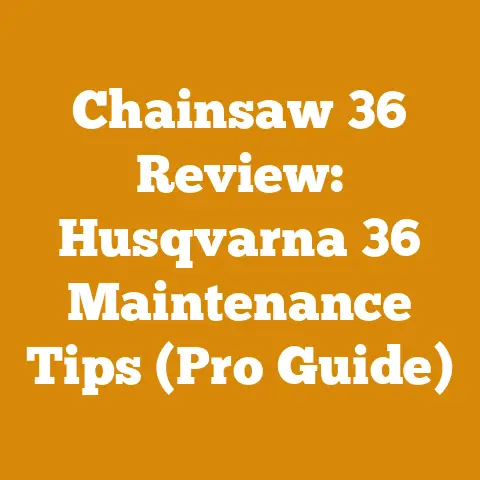Poulan Chainsaw Fuel Line Route (5 Expert Tips for Smooth Running)
Let’s face it, a Poulan chainsaw sputtering and dying mid-cut is a frustrating experience.
In my years of working with wood, both professionally and for my own firewood needs, I’ve learned that often the culprit isn’t a major engine issue, but something as simple as a faulty or improperly routed fuel line.
Think of the fuel line as the heart of your saw, delivering the lifeblood that keeps it running.
Get the fuel line route wrong, and you’re essentially giving your saw a heart attack.
This guide isn’t just about fixing a problem; it’s about understanding your Poulan chainsaw and ensuring it runs smoothly for years to come.
I’m going to share my expert tips for ensuring your Poulan chainsaw fuel line is routed correctly, preventing common issues, and keeping your saw roaring to life every time.
Poulan Chainsaw Fuel Line Route (5 Expert Tips for Smooth Running)
Understanding the Poulan Chainsaw Fuel System
Before diving into the nitty-gritty of fuel line routing, it’s crucial to understand the basics of your Poulan chainsaw’s fuel system.
It’s more than just a tank and a line; it’s a carefully designed system that needs to be understood to be maintained.
The system consists of:
- Fuel Tank: Holds the fuel mixture (typically gasoline and 2-cycle oil).
- Fuel Filter: Prevents debris from entering the fuel line and carburetor.
- Fuel Line(s): Transports fuel from the tank to the carburetor.
Poulan chainsaws typically have two fuel lines: a fuel supply line and a return line. - Carburetor: Mixes fuel and air in the proper ratio for combustion.
- Primer Bulb: Helps to prime the carburetor with fuel for easier starting.
Understanding how each component interacts is key to diagnosing fuel-related issues.
A clogged filter, a cracked fuel line, or an improperly connected line can all lead to starting problems, poor performance, and even engine damage.
I can’t stress enough how important it is to regularly inspect these components!
Tip 1: Identifying the Correct Fuel Line Routing
This is where things get tricky.
Many Poulan chainsaw models look similar, but their fuel line routing can differ slightly.
A quick look on YouTube can reveal some videos that are misleading or simply wrong.
Getting the routing wrong is a surefire way to cause problems.
The General Setup:
- Fuel Supply Line: This line usually runs from the fuel filter inside the tank to the carburetor’s fuel inlet.
It’s often the longer of the two lines. - Fuel Return Line: This line returns excess fuel from the carburetor back to the fuel tank.
It’s usually shorter and connects to a fitting on the carburetor body.
How to Confirm the Correct Routing:
- Consult Your Poulan Chainsaw’s Manual: This is your best resource.
The manual will provide a diagram of the fuel line routing specific to your model.
If you don’t have the manual, you can often find it online on the Poulan website or through online parts retailers. - Take Pictures Before Disassembly: If you’re replacing fuel lines, take clear photos of the existing routing before you disconnect anything.
This will serve as a valuable reference when you reassemble everything.
I have learned this the hard way many times! - Check Online Parts Diagrams: Websites that sell Poulan chainsaw parts often have exploded diagrams that show the fuel line routing.
These diagrams can be very helpful, especially if your manual is unclear. - Compare to Similar Models: If you can’t find specific information for your model, look at diagrams for similar Poulan chainsaws.
While not a perfect solution, it can give you a general idea of the correct routing.
What Happens if the Routing is Wrong?
Incorrect fuel line routing can lead to several problems:
- Difficulty Starting: The carburetor may not receive fuel, making it hard to start the engine.
- Poor Performance: The engine may run rough, stall frequently, or lack power.
- Engine Damage: In severe cases, incorrect routing can lead to fuel starvation, causing engine damage.
Real-World Example: I once worked on a Poulan chainsaw where the owner had reversed the fuel lines.
The saw would start but quickly stall.
After correcting the routing, the saw ran perfectly.
It’s a simple mistake, but it can have significant consequences.
Takeaway: Always double-check the fuel line routing before and after replacing fuel lines.
Your manual, photos, and online diagrams are your best friends in this process.
Tip 2: Choosing the Right Fuel Line Size and Material
Using the wrong fuel line size or material can lead to leaks, cracks, and fuel delivery problems.
Fuel Line Size:
Poulan chainsaws typically use fuel lines with an inner diameter (ID) of either 1/8 inch or 3/32 inch.
The correct size will depend on your specific model.
-
How to Determine the Correct Size:
- Check Your Manual: The manual should specify the correct fuel line size.
- Measure the Old Fuel Line: If you’re replacing fuel lines, measure the ID of the old line.
- Consult Online Parts Retailers: Many online parts retailers list the fuel line size for specific Poulan chainsaw models.
-
Why Size Matters:
- Too Small: A fuel line that is too small will restrict fuel flow, leading to poor performance and potential engine damage.
- Too Large: A fuel line that is too large may not seal properly, leading to leaks and air leaks.
Fuel Line Material:
The material of the fuel line is also important.
Standard rubber fuel lines can deteriorate quickly when exposed to gasoline and oil.
- Recommended Material: Tygon Fuel Line Tygon fuel line is a synthetic rubber that is resistant to gasoline, oil, and other chemicals.
It’s more expensive than standard rubber fuel line, but it will last much longer and provide better performance.
I exclusively use Tygon fuel lines in my chainsaws. - Why Tygon is Superior:
- Durability: Tygon is much more resistant to cracking, swelling, and hardening than standard rubber.
- Flexibility: Tygon remains flexible even in cold weather, making it easier to install and less likely to crack.
- Fuel Resistance: Tygon is designed to withstand the harsh chemicals in gasoline and oil.
Cost Analysis: While Tygon fuel line costs more upfront, its durability and resistance to deterioration mean you’ll replace it less often.
This translates to long-term savings and reduced downtime.
Real-World Example: I once used standard rubber fuel line on a Poulan chainsaw.
Within a few months, the line had hardened and cracked, leading to a fuel leak.
After switching to Tygon, I haven’t had any fuel line problems since.
Takeaway: Invest in Tygon fuel line of the correct size for your Poulan chainsaw.
It’s a small investment that will pay off in the long run with improved performance and reliability.
Tip 3: Replacing Fuel Lines the Right Way
Replacing fuel lines is a straightforward process, but there are a few key steps to follow to ensure a successful repair.
Tools You’ll Need:
- New Fuel Line (Tygon recommended)
- Small Screwdriver or Pick: For removing old fuel lines.
- Needle-Nose Pliers: For gripping and maneuvering fuel lines.
- Fuel Filter: Replace the fuel filter whenever you replace the fuel lines.
- Razor Blade or Utility Knife: For trimming fuel lines.
- Gloves: To protect your hands from gasoline.
Step-by-Step Replacement Guide:
- Drain the Fuel Tank: Before you start, drain the fuel tank to prevent spills.
- Remove the Old Fuel Lines: Use a small screwdriver or pick to carefully disconnect the old fuel lines from the carburetor and fuel filter.
Be gentle to avoid damaging the fittings. - Remove the Fuel Filter: Fish out the old fuel filter from the fuel tank.
You may need to use needle-nose pliers to reach it. - Install the New Fuel Filter: Attach the new fuel filter to the end of the fuel supply line (the longer line).
- Route the Fuel Lines: Carefully route the fuel lines through the chainsaw body, following the correct routing diagram.
- Connect the Fuel Lines to the Carburetor: Connect the fuel supply line to the fuel inlet on the carburetor and the fuel return line to the return fitting.
Make sure the lines are securely attached. - Trim the Fuel Lines: If the fuel lines are too long, trim them to the correct length using a razor blade or utility knife.
- Check for Leaks: After replacing the fuel lines, fill the fuel tank with fuel and check for leaks.
Start the engine and let it run for a few minutes to ensure there are no leaks.
Common Mistakes to Avoid:
- Forcing the Fuel Lines: Don’t force the fuel lines onto the fittings.
If they’re too tight, lubricate them with a little bit of oil or gasoline. - Damaging the Fittings: Be careful not to damage the fittings on the carburetor or fuel tank when removing or installing the fuel lines.
- Using the Wrong Size Fuel Line: As mentioned earlier, using the wrong size fuel line can lead to leaks and fuel delivery problems.
- Skipping the Fuel Filter: Always replace the fuel filter when you replace the fuel lines.
A clogged fuel filter can restrict fuel flow and damage the engine. - Not Checking for Leaks: Always check for leaks after replacing the fuel lines.
Fuel leaks can be dangerous and can also damage the engine.
Pro Tip: When inserting the fuel line into the tank, I find it helpful to use a small piece of wire as a guide.
Thread the wire through the hole in the tank, attach it to the end of the fuel line, and then pull the wire through to guide the fuel line into place.
Takeaway: Replacing fuel lines is a relatively simple task, but it’s important to follow the correct steps and avoid common mistakes.
With the right tools and a little patience, you can easily replace the fuel lines on your Poulan chainsaw and keep it running smoothly.
Tip 4: Addressing Common Fuel Line Problems
Even with proper routing and high-quality fuel lines, problems can still arise.
Here’s how to troubleshoot some common issues:
Problem 1: Fuel Line Leaks
- Symptoms: Fuel leaking from the fuel lines, fuel smell, poor performance.
- Causes: Cracked or damaged fuel lines, loose fittings, worn-out fuel filter.
- Solutions:
- Inspect the Fuel Lines: Check the fuel lines for cracks, kinks, or other damage.
Replace any damaged lines. - Tighten the Fittings: Make sure the fuel lines are securely attached to the carburetor and fuel filter.
Tighten the fittings if necessary. - Replace the Fuel Filter: A worn-out fuel filter can cause fuel leaks.
Replace the fuel filter if it’s old or damaged.
- Inspect the Fuel Lines: Check the fuel lines for cracks, kinks, or other damage.
Problem 2: Fuel Line Clogs
- Symptoms: Difficulty starting, poor performance, engine stalling.
- Causes: Debris in the fuel tank, clogged fuel filter, kinked fuel lines.
- Solutions:
- Clean the Fuel Tank: Drain the fuel tank and clean it out to remove any debris.
- Replace the Fuel Filter: A clogged fuel filter can restrict fuel flow.
Replace the fuel filter. - Check for Kinked Fuel Lines: Make sure the fuel lines are not kinked or pinched.
Replace any kinked lines.
Problem 3: Air Leaks in the Fuel Line
- Symptoms: Difficulty starting, erratic idling, poor performance.
- Causes: Loose fuel lines, cracked fuel lines, damaged carburetor gasket.
- Solutions:
- Tighten the Fuel Lines: Make sure the fuel lines are securely attached to the carburetor and fuel filter.
- Inspect the Fuel Lines: Check the fuel lines for cracks or damage.
Replace any damaged lines. - Check the Carburetor Gasket: A damaged carburetor gasket can cause air leaks.
Replace the gasket if necessary.
Problem 4: Fuel Line Disconnection
- Symptoms: Chainsaw not starting, fuel leaking.
- Causes: Vibration, loose fitting.
- Solutions:
- Re-attach Fuel Line: Re-attach the fuel line to the correct nozzle.
- Secure with Clamp: Use a clamp to secure the fuel line to the nozzle.
Using a Vacuum Tester:
For hard-to-diagnose air leaks, a vacuum tester can be invaluable.
Connect the tester to the fuel line and create a vacuum.
If the vacuum drops quickly, it indicates a leak.
Real-World Example: I had a Poulan chainsaw that was running poorly and stalling frequently.
After inspecting the fuel lines, I found a small crack in one of the lines.
Replacing the fuel line solved the problem.
Takeaway: By understanding the common fuel line problems and how to troubleshoot them, you can keep your Poulan chainsaw running smoothly and avoid costly repairs.
Regular inspection and maintenance are key to preventing these issues.
Tip 5: Preventative Maintenance for Long-Lasting Fuel Lines
Prevention is always better than cure.
Regular maintenance can significantly extend the life of your fuel lines and prevent many of the problems discussed above.
Key Maintenance Practices:
- Use Fresh Fuel: Old fuel can break down and damage fuel lines.
Always use fresh fuel (less than 30 days old) and mix it with the correct ratio of 2-cycle oil. - Store Fuel Properly: Store fuel in a sealed container in a cool, dry place.
- Drain the Fuel Tank Before Storage: If you’re not going to use your chainsaw for an extended period, drain the fuel tank to prevent the fuel from breaking down and damaging the fuel lines.
- Inspect Fuel Lines Regularly: Check the fuel lines for cracks, kinks, and other damage on a regular basis.
Replace any damaged lines immediately. - Replace the Fuel Filter Regularly: Replace the fuel filter at least once a year, or more often if you use your chainsaw frequently.
- Use a Fuel Stabilizer: If you’re going to store your chainsaw for an extended period, add a fuel stabilizer to the fuel tank to prevent the fuel from breaking down.
- Clean the Air Filter: A dirty air filter can cause the engine to run lean, which can damage the fuel lines.
Clean the air filter regularly.
Maintenance Schedule:
- Before Each Use:
- Inspect fuel lines for cracks or leaks.
- Check fuel level.
- Monthly:
- Clean the air filter.
- Inspect the fuel filter.
- Annually:
- Replace the fuel filter.
- Inspect and potentially replace fuel lines, especially if using standard rubber lines.
Case Study: The Power of Preventative Maintenance:
I once worked with a logging company that had a fleet of Poulan chainsaws.
They implemented a strict preventative maintenance program, including regular fuel line inspections and replacements.
As a result, they experienced significantly fewer fuel-related problems and reduced downtime.
Takeaway: By following these preventative maintenance practices, you can extend the life of your fuel lines, improve the performance of your Poulan chainsaw, and avoid costly repairs.
A little bit of maintenance goes a long way!
In conclusion, mastering the Poulan chainsaw fuel line route is essential for optimal performance and longevity.
By correctly identifying the routing, selecting the right fuel line, executing proper replacement techniques, addressing common issues, and implementing preventative maintenance, you can ensure your chainsaw runs smoothly for years.
Remember that these tips are not just theoretical; they’re based on my real-world experiences and observations.
I hope this guide empowers you to tackle any fuel line challenges you may encounter.
Now, go forth and keep your Poulan chainsaw roaring!






